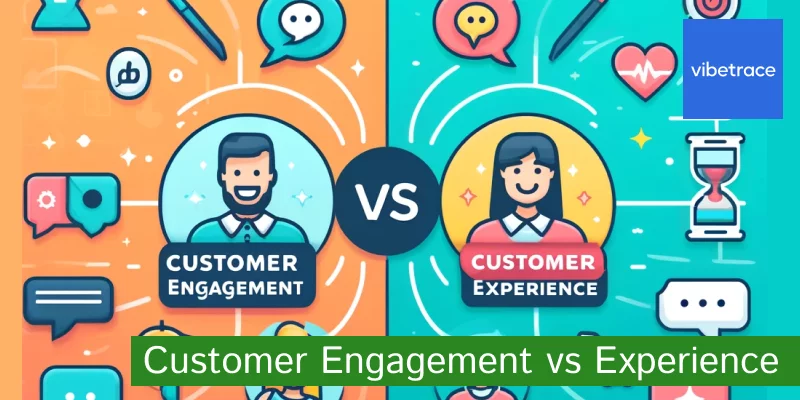Customer engagement and customer experience are closely related concepts in the realm of business and marketing.
They have distinct meanings and roles and here are some key differences between the two:
Customer Engagement
- Definition:
- Customer engagement refers to the interaction between a customer and a brand. It encompasses the various ways customers interact with a brand, including through marketing campaigns, social media, customer service, and other touchpoints.
- Focus:
- It focuses on the actions and behaviors of the customer. Engagement is about how customers participate and interact with the brand, whether actively or passively.
- Scope:
- Engagement is typically measured through specific activities such as social media likes, shares, comments, website visits, email opens, and participation in loyalty programs.
- Objective:
- The primary objective of customer engagement is to build a relationship with the customer that fosters loyalty and encourages repeat interactions. It’s about keeping the customer involved and interested in the brand.
- Measurement:
- Customer engagement is often measured through metrics such as click-through rates, social media engagement rates, time spent on site, and the number of interactions.
Customer Experience
- Definition:
- Customer experience (CX) refers to the overall perception a customer has of a brand based on all their interactions and touchpoints with the brand. It is a broader concept that encompasses every aspect of a customer’s journey with the brand.
- Focus:
- CX focuses on the feelings and perceptions of the customer. It is about the customer’s overall impression of the brand, which is shaped by all their interactions.
- Scope:
- The scope of customer experience includes all touchpoints and channels, such as in-store visits, online shopping, customer service interactions, product use, and after-sales support.
- Objective:
- The objective of customer experience is to ensure a seamless, positive, and memorable journey for the customer across all touchpoints. It’s about creating a holistic and satisfying experience that enhances the customer’s overall perception of the brand.
- Measurement:
- Customer experience is measured through metrics such as Net Promoter Score (NPS), Customer Satisfaction (CSAT) scores, Customer Effort Score (CES), and qualitative feedback from surveys and reviews.
Net Promoter Score
Do you like this article?
Join our CX for Retail dedicated newsletter!

Stay connected to what’s really important to optimize your digital revenues.
By clicking the button, you accept our Terms & Conditions. Also you will need to confirm your email address.
| Customer Experience | Customer Engagement |
| How the brand makes the customer feel | What the brand does to connect with custoemr |
| Perception customer has about the brand | Omni-channel interactions with the brand |
| Measures perception (NPS score), satisfaction | Measure interactions (clicks, events) |
| More subjective, since perception is different and vary | More objective, since is easier measurable |
| Focus is to exceed customer expectations | Focus is to provide value that can be easy tracked down |
How can Vibetrace help improve Customer Experience
1. Personalized Customer Journeys
- Behavioral Tracking: Vibetrace can track customer behavior across different touchpoints, allowing the platform to understand individual preferences and habits.
- Personalized Content: Using data from behavioral tracking, Vibetrace can deliver personalized content, product recommendations, and offers that resonate with each customer, enhancing their overall experience.
2. Automated Customer Interactions
- Marketing Automation: Vibetrace can automate email campaigns, SMS notifications, webpush, website and other communication channels to ensure timely and relevant messages are sent to customers based on their interactions and preferences.
- Lifecycle Campaigns: The platform can set up automated campaigns that guide customers through different stages of their journey, from onboarding to retention, ensuring a smooth and engaging experience.
3. Customer Segmentation
- Advanced Segmentation: Vibetrace can segment customers based on various criteria such as behavior, purchase history, demographics, or marketing engagement levels. This enables targeted marketing efforts and personalized experiences for different customer groups.
4. Real-Time Analytics and Insights
- Customer Insights: Vibetrace provides real-time analytics and reports on customer behavior, engagement, and feedback. These insights help businesses understand what drives customer satisfaction and where improvements are needed.
- A/B Testing: The platform can facilitate A/B testing for different customer experience strategies, allowing businesses to determine what works best for their audience.
5. Customer Feedback Management
- Surveys and Feedback: Vibetrace can integrate surveys and feedback forms into the customer journey to gather insights on customer satisfaction and pain points. This feedback can be used to make data-driven improvements to the customer experience.
- Sentiment Analysis: The platform can analyze customer feedback to gauge overall sentiment, helping businesses identify trends and address issues promptly.
8. Customer Retention and Loyalty Programs
- Loyalty Programs: Vibetrace can help design and manage loyalty programs that reward customers for their engagement and purchases, fostering long-term loyalty.
- Churn Prediction: The platform can use predictive analytics to identify customers at risk of churning and proactively engage them with targeted offers and interventions.
Summary
Now that we understand what both are about, here’s a summary.
- Customer Engagement is about the interactions and activities between the customer and the brand, focusing on building relationships and keeping the customer actively involved.
- Customer Experience is about the overall journey and perception of the brand, focusing on delivering a positive, seamless, and memorable experience across all touchpoints.

